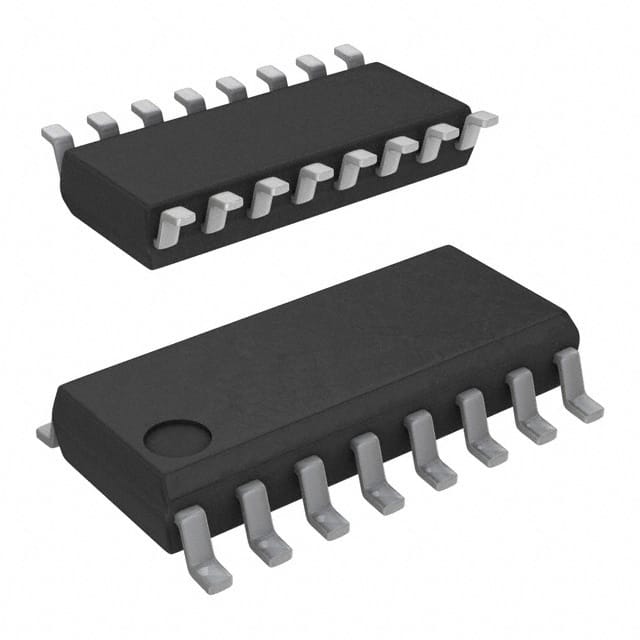CD74HCT153MG4
Product Overview
- Category: Integrated Circuit
- Use: Digital Multiplexer/Demultiplexer
- Characteristics: High-Speed, CMOS Logic, Dual 4-to-1 Configuration
- Package: SOIC (Small Outline Integrated Circuit)
- Essence: The CD74HCT153MG4 is a dual 4-to-1 multiplexer/demultiplexer integrated circuit. It is designed to handle high-speed digital signals and is based on CMOS logic technology.
- Packaging/Quantity: The CD74HCT153MG4 is available in a standard SOIC package and is typically sold in reels or tubes containing multiple units.
Specifications
- Supply Voltage: 2V - 6V
- Logic Family: HCT
- Number of Inputs: 8
- Number of Outputs: 4
- Propagation Delay: 15 ns (typical)
- Operating Temperature Range: -40°C to +85°C
Pin Configuration
The CD74HCT153MG4 has a total of 16 pins, which are assigned specific functions as follows:
__ __
A0 |1 \__/ 16| Vcc
A1 |2 15| Y0
B0 |3 14| Y1
B1 |4 CD 13| Y2
C0 |5 74 12| Y3
C1 |6 HCT 11| GND
GND |7 10| S0
S1 |8 9| S2
-- --
Functional Features
- Dual 4-to-1 Multiplexer/Demultiplexer: The CD74HCT153MG4 can function as two independent 4-to-1 multiplexers or demultiplexers.
- High-Speed Operation: It is designed to operate at high speeds, making it suitable for applications requiring fast data switching.
- CMOS Logic Technology: The use of CMOS logic ensures low power consumption and compatibility with a wide range of digital systems.
Advantages and Disadvantages
Advantages
- Versatile Functionality: The CD74HCT153MG4 can be used as both a multiplexer and a demultiplexer, providing flexibility in various digital circuit designs.
- High-Speed Performance: With a propagation delay of only 15 ns, it enables rapid data transmission and processing.
- Low Power Consumption: The CMOS technology used in the CD74HCT153MG4 ensures efficient power usage, making it suitable for battery-powered devices.
Disadvantages
- Limited Input/Output Count: The CD74HCT153MG4 has 8 inputs and 4 outputs, which may not be sufficient for complex digital systems requiring a higher number of channels.
- Temperature Sensitivity: Although it operates within a wide temperature range, extreme temperatures can affect its performance.
Working Principles
The CD74HCT153MG4 operates based on the principles of multiplexing and demultiplexing. In the multiplexer mode, it selects one of the four input channels and routes it to the output based on the control inputs (S0 and S1). In the demultiplexer mode, it performs the reverse operation by taking a single input and routing it to one of the four output channels.
The internal circuitry of the CD74HCT153MG4 consists of logic gates and flip-flops that enable the selection and routing of data signals. The CMOS technology used ensures high-speed operation and low power consumption.
Detailed Application Field Plans
The CD74HCT153MG4 finds applications in various digital systems, including:
- Data Communication Systems: It can be used for data multiplexing/demultiplexing in communication protocols such as UART, SPI, or I2C.
- Digital Audio/Video Equipment: The CD74HCT153MG4 can be utilized in audio/video switchers and routers to select different input sources.
- Industrial Control Systems: It is suitable for controlling multiple sensors or actuators by selecting the desired input/output channels.
- Computer Peripherals: The CD74HCT153MG4 can be employed in devices like printers, scanners, or disk drives for data routing purposes.
Detailed and Complete Alternative Models
- SN74HCT153: This is a similar dual 4-to-1 multiplexer/demultiplexer IC from Texas Instruments, offering comparable functionality and performance.
- MC74HCT153: Manufactured by ON Semiconductor, this IC provides the same multiplexer/demultiplexer capabilities with slight variations in specifications.
These alternative models can be considered as replacements for the CD74HCT153MG4, depending on availability and specific requirements.
Lista 10 Vanliga frågor och svar relaterade till tillämpningen av CD74HCT153MG4 i tekniska lösningar
Sure! Here are 10 common questions and answers related to the application of CD74HCT153MG4 in technical solutions:
Q: What is CD74HCT153MG4? A: CD74HCT153MG4 is a dual 4-input multiplexer with Schmitt-trigger inputs, which is commonly used in digital circuits.
Q: What are the key features of CD74HCT153MG4? A: Some key features include low power consumption, wide operating voltage range, high-speed operation, and compatibility with TTL logic levels.
Q: How can CD74HCT153MG4 be used in technical solutions? A: CD74HCT153MG4 can be used for data routing and selection purposes in various applications, such as data multiplexing, signal switching, and address decoding.
Q: What is the maximum operating frequency of CD74HCT153MG4? A: The maximum operating frequency of CD74HCT153MG4 is typically around 50 MHz.
Q: What is the supply voltage range for CD74HCT153MG4? A: CD74HCT153MG4 operates within a supply voltage range of 2V to 6V.
Q: Can CD74HCT153MG4 handle both analog and digital signals? A: No, CD74HCT153MG4 is designed to handle digital signals only and is not suitable for analog applications.
Q: Does CD74HCT153MG4 have built-in protection against electrostatic discharge (ESD)? A: Yes, CD74HCT153MG4 has built-in ESD protection to prevent damage from static electricity.
Q: What is the typical propagation delay of CD74HCT153MG4? A: The typical propagation delay of CD74HCT153MG4 is around 15 ns.
Q: Can CD74HCT153MG4 be used in high-temperature environments? A: Yes, CD74HCT153MG4 has a wide operating temperature range of -55°C to 125°C, making it suitable for various industrial applications.
Q: Are there any recommended application circuits or reference designs available for CD74HCT153MG4? A: Yes, the datasheet of CD74HCT153MG4 provides application information and example circuits that can help in designing with this IC.
Please note that these answers are general and may vary depending on specific datasheets and manufacturers' recommendations.


